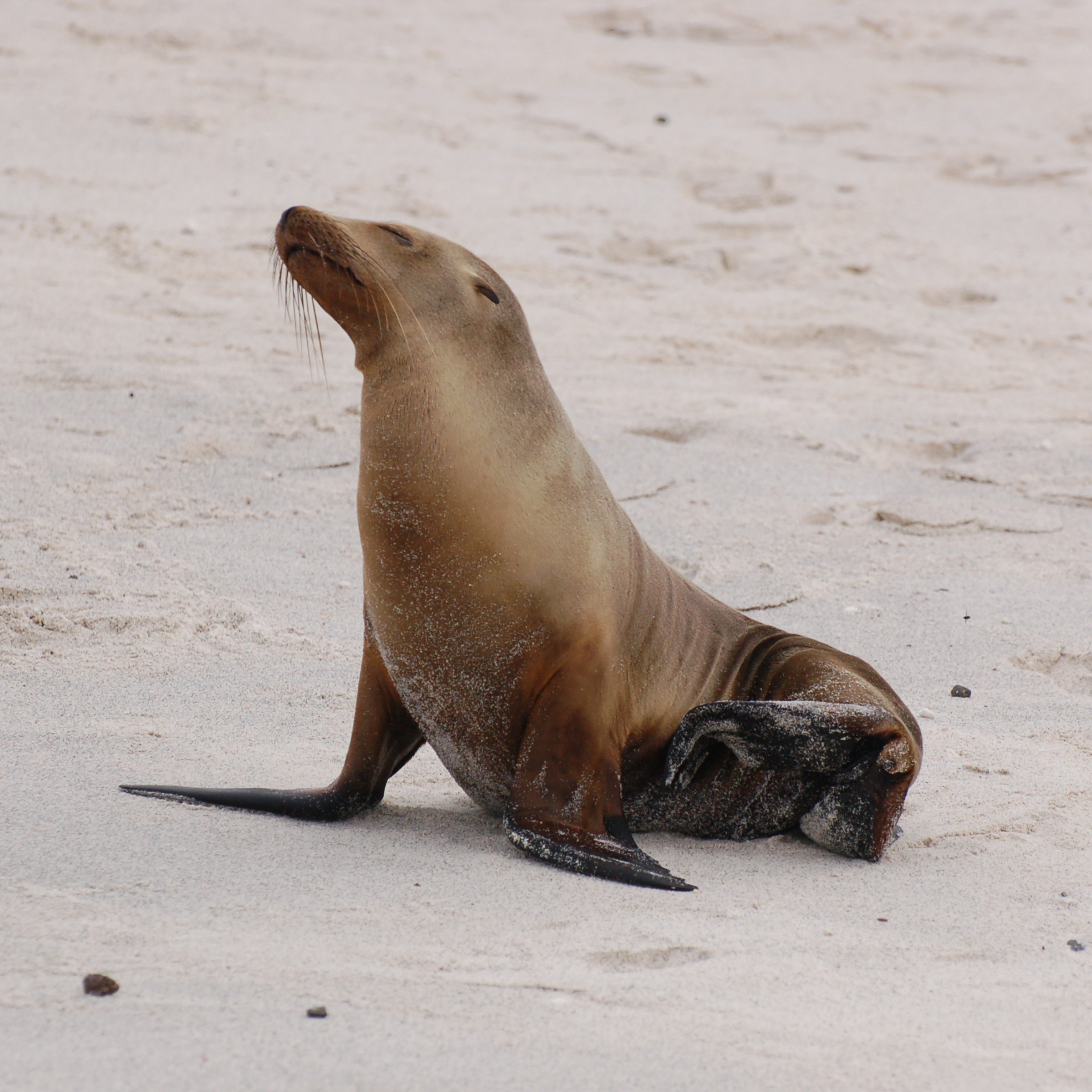- Galapagos Fur Seal
Taxobox
name = Galapagos Fur Seal
status = VU
trend = unknown
status_system = iucn2.3

image_width = 200px
regnum =Animal ia
phylum = Chordata
classis =Mammal ia
ordo =Carnivora
subordo =Pinnipedia
familia =Otariidae
subfamilia =Arctocephalinae
genus = "Arctocephalus "
species = "A. galapagoensis"
binomial = "Arctocephalus galapagoensis"
binomial_authority = Heller, 1904The Galapagos Fur Seal ("Arctocephalus galapagoensis") breeds on the
Galapagos Islands in the eastern Pacific, west ofEcuador .Description
The Galapagos fur seal is the smallest of all
pinnipeds , or fin-footed mammals. They have a grayish brown fur coat. The adult males of the species average at 1.5 meters in length and 64 kilograms in weight. The females average at 1.2 meters in length and 28 kilograms in weight. The Galapagos fur seal spends more time out of the water than almost any other seal. On average, 70% of their time is spent on land. Most seal species spend 50% of their time on land and 50% in the water.Range and Habitat
The Galapagos fur seal is
endemic to the Galapagos Islands, like most species found here, meaning you will not find them anywhere else in the world. The Galapagos are a chain of islands found approximately 972 kilometers west of Ecuador. The seals live on the rocky shores of the islands which tend to be on the west side of the islands, leaving only to feed. These seals do not migrate and remain near the islands their entire lives, which averages at about 20 years.Reproduction
The Galapagos fur seals live in large colonies on the rocky shores. These colonies are then divided up into territories by the female seals during breeding season. Every mother seal claims a territory for herself and breeds her pups here. This seal has a longer nursing period than any other species of seal. Females have been known to nurse up to three year old pups, but usually it takes somewhere from one to two years before the pup leaves and lives on its own. The reason some pups take longer than others to develop is because when there is a shortage of food, which can be caused by
El Nino , the mothers can not properly nourish their young. El Nino has a devastating effect on the fur seals of the Galapagos. During El Nino years food supplies can drop extremely low, causing many seals to die from starvation. This is because El Nino raises the temperatures of the waters around the Galapagos, causing the seals’ food supply to migrate to cooler waters.During the nursing years, females will leave for up to four days at a time to forage for food. They then return to rest and feed the pup for just one day and then return back to the sea and repeat the process. While the mother is away, the pup must be careful because other female seals are extremely violent against pups that are not their own. Female seals will defend their territories to the death. They do not want to lose their area because they will not be able to breed then. If a pup wanders into another female’s territory, the female sees this as a threat and will attack or may even kill the pup.
Feeding and Predation
The Galapagos fur seal feeds primarily on fish and
cephalopods . They feed relatively close to shore and near the surface, but have been seen at depths of 169 meters. They primarily feed at night because their prey is much easier to catch then. During normal years, food is relatively plentiful. However, during an El Nino year there can be fierce competition for food and many young pups die during these years. The adult seals feed themselves before their young and during particularly rough El Nino years, most of the young seal populations will die.The Galapagos fur seal has virtually no constant predators to be wary of. Occasionally, sharks and Orca whales have been seen feeding on the seals, but this is very rare. Sharks and
Orca whales are the main predator of most other seal species, but their migration path does not usually pass the Galapagos.Conservation
The Galapagos fur seals have had a declining population since the 19th century. Thousands of these seals were killed for their fur in the 1800’s by poachers. Starting in 1959, Ecuador established strict laws to protect these animals. The government of Ecuador declared the Galapagos Islands a national park and since then no major poaching has occurred.Despite the laws, another tragic blow to their population occurred during the 1982-1983 El Nino weather event. Almost all of the seal pups died, and about 30% of the adult population was wiped out. The population is relatively stable now and is on the rise. Since 1983, no major calamity has occurred to decrease their population significantly.
References
*MarineBio.(1999). Retrieved September 22, 2008, from http://marinebio.org/species.asp?id=293
*Seal Conservation Society.(n.d.). Retrieved September 22, 2008, from http://www.pinnipeds.org/species/galfursl.htm
* Listed as Vulnerable (VU A2d v2.3)
*
Wikimedia Foundation. 2010.
